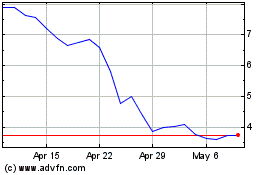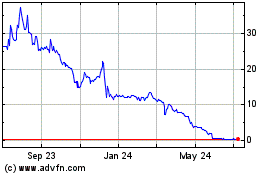Platform for Functional Isolation of Invasive
Circulating Tumor Cells Empowers Three LineaRx Product Categories:
Diagnostics, Prognostics and Therapeutics; Creates Integrated
Product and Service Offering
LineaRx, Inc. (“LineaRx”), a wholly-owned subsidiary of Applied
DNA Sciences, Inc. (“Applied DNA or the Company,” NASDAQ:APDN),
announced today that it has acquired the physical assets and
Intellectual Property (IP) of Vitatex Inc. (“Vitatex”), a private
biotechnology company focused on advancing personalized medicine
with an innovative solution that isolates Invasive Circulating
Tumor Cells (iCTCs) from standard patient blood samples. Vitatex’s
solution identifies metastatic cells often before primary tumors
are visible to other diagnostic technologies, when preventive care
for impending cancer is still an option.
“We are honored to now include Vitatex executives on our team
and employ its powerful technology within our platform,” said Dr.
James Hayward, president and CEO of LineaRx. “We believe that the
sophisticated technology sets us apart and integrates closely with
the LineaRx service and technology offerings, broadening our
addressable markets and shortening our development cycle.”
Invasive Circulating Tumor Cells (iCTCs) are isolated from the
blood using Vitatex’s patented, novel functional assay that
requires the cells to duplicate the metastatic behaviors of
intravasation (leaving a primary tumor and initiating escape
through a capillary or lymphatic vessel) and extravasation (exiting
capillaries and lymphatic vessels and entering organs to form
aggressive secondary tumors.) These assays are highly personalized
and offer information regarding the metastatic potential of each
individual’s unique cancer. The worldwide market for CTC
technologies is projected to reach $17.6 billion by 2025 at a 20%
CAGR over the period1.
In contrast to competitive technologies that only recognize
parts of cancer DNA, the Vitatex platform captures living cancer
cells that enter the blood stream at very low rates. As such, they
can be cultured and challenged against panels of cancer therapies
to optimize selection of treatment tailored to each patient.
Genomic information gathered from the iCTCs and associated
lymphocytes that have already recognized the iCTCs as cancer can be
used to target individualized cancer antigens (neoantigens) in
immune therapies such as CAR T.
“We are thrilled to be joining LineaRx, whose technologies we
believe will alter the future of cancer therapy. Our combined
platforms offer opportunities to diagnose cancer early, personalize
redirected cell therapies, and predict outcomes across many cancer
indications,” stated Dr. Wen-Tien Chen, Research Professor of
Medical Oncology at Stony Brook University, and the founder and
president of Vitatex.
Dr. Chen, who joins LineaRx as a Consulting Emeritus Scientist
and Principal Investigator, discovered the enzyme seprase while
serving as Director of the Tumor Invasion and Metastasis Program at
Georgetown University. Seprase is a protease (a protein-digesting
enzyme) secreted at the invasive front of metastasizing cancers.
Included in the IP acquired by LineaRx, are several hybridoma cell
lines, including one that produces antibodies directed against
seprase. These antibodies have potential both as therapeutics as
well as for characterizing iCTCs as cancerous.
Dr. Michael Pearl, Professor of Gynecological Oncology and
Medical Director of the Cancer Center Clinical Trials Office at
Stony Brook University Hospital, and author of multiple papers on
iCTCs, stated: “Although the prevalence of ovarian cancer is very
low there is a high unmet need for better therapies. As we have
recently shown, the positive predictive value (PPV) of using iCTCs
as a screening test for patients who are at high risk, raises the
PPV to well over 97%.”
LineaRx plans to work with existing companies in the diagnostic
market and enhance the functionality and sensitivity of their
cancer diagnostic assays. Longer term, the Vitatex platform is
intended to be used to generate ultra-personalized redirected cell
therapies, produced at the point of care, to cancers with high
mutation burdens that also have the greatest metastatic potential.
LineaRx intends to develop and out-license the technology as an
early cancer diagnostic, and a prognostic to follow the course of
contemporary cancer therapies including such redirected cell
therapies as CAR T (T cells redirected against a patient’s cancer
by an inserted nucleic acid that codes for Chimeric Antigen
Receptors), and, to develop
therapeutics that utilize LineaRx’s unique DNA manufacturing based
upon large-scale polymerase chain reaction (PCR).
LineaRx intends to design synthetic genes to redirect immune
cells against antigens that are recognized by leukocytes that
comigrate with the iCTCs, one of the unique features of the Vitatex
platform. Vitatex has been the beneficiary of more than $7 million
of NCI funding over the course of its history, and LineaRx has
already begun the application for a new contract to support
commercialization, with matching funds from commercial partners.
Dr. Chen continued, “We believe LineaRx has the commercial and
compliance experience to bring our technologies quickly to
commercial practice to aid the cancer community.”
Two senior members of the Vitatex team have joined the parent
company of LineaRx, Applied DNA: Qiang Zhao, MD and Huan Dong,
Ph.D. A Licensing Agreement was also signed between LineaRx and The
Research Foundation for The State University of New York, since the
discoveries claimed in the licensed patents were made on the campus
of Stony Brook University. Peter Donnelly, Associate Vice President
for Technology Partnerships for Stony Brook University stated: “We
are pleased to expand our relationship with one of our community’s
most productive and insightful entrepreneurs. The management at
LineaRx has the experience, technical and compliance insights, and
indefatigable drive to bring these technologies to market
quickly.”
The acquisition of Vitatex by LineaRx was structured as an
“earn-out,” allowing LineaRx to realize value before paying for it.
Initial payment comprised $300,000 worth of equity in LineaRx at a
valuation of $25 million for LineaRx. Subsequent payments are
milestone-based, rising to a maximum of $1 million in value,
comprising a total of $800,000 in LineaRx equity (based on the
then-current market capitalization of LineaRx) and $200,000 in
cash.
Dr. Kenneth Kaushansky, senior vice president of Health Sciences
for Stony Brook University, and Dean of the Renaissance School of
Medicine, and himself an expert on myeloproliferative cancers,
stated: “Dr. Chen has invented and patented a fundamentally new
technology for the capture and subsequent analysis of CTCs. With
much excitement, we have watched the commercial progress of that
technology as it has developed via multiple rounds of highly
competitive SBIR funding, here at the Stony Brook University
Medical Center. As have many others, we have been fascinated by the
potential for such CTC-based approaches to cancer diagnostics. But
arguably, what has been generally lacking in the field of CTC
diagnostics is the ability to capture such CTCs based on the
functional characteristics of a tumor cell, which the Vitatex
technology is uniquely positioned to deliver. The recent pairing
with LineaRx will provide the opportunity to take the Vitatex CTC
technology to the next level, in terms of manufacturing scale-up,
ISO and cGMP validation and the direct coupling of the Vitatex
technology to a wide range of “best in breed” DNA-based and
protein-based diagnostic assay technologies, which LineaRx already
supports with its other commercial partners.”
Dr. Hayward summarized: “Dr. Chen’s lifetime contribution to the
understanding of the mechanisms of cancer metastasis are
inestimable. We are very fortunate to be able to work with his team
to evolve and commercialize these technologies to improve the lives
of cancer patients.”
About LineaRx
LineaRx seeks to commercialize the biotherapeutic value of
Applied DNA’s deep expertise and experience in the design,
manufacture and chemical modification of DNA by large scale
polymerase chain reaction (“PCR”). Linear DNA is a form of DNA
distinct from the circular form of DNA most commonly produced in
plasmids and grown in bacteria. Plasmids are extrachromosomal DNA
found in bacteria and are associated with the genes for antibiotic
resistance which are often exchanged between bacteria and
consequentially, are seen by many to embody a serious threat to
global health. In addition, many nucleic acid-based therapies also
rely on viral vectors for efficient transfection and expression of
plasmid DNA. These viral vectors carry additional nontrivial risks
and are extremely time consuming and expensive to manufacture.
About Applied DNA Sciences
Applied DNA is a provider of molecular technologies that enable
supply chain security, anti-counterfeiting and anti-theft
technology, product genotyping and pre-clinical nucleic acid-based
therapeutic drug candidates.
Applied DNA makes life real and safe by providing innovative,
molecular-based technology solutions and services that can help
protect products, brands, entire supply chains, and intellectual
property of companies, governments and consumers from theft,
counterfeiting, fraud and diversion.
Visit adnas.com for more information. Follow us on Twitter and
LinkedIn. Join our mailing list.
Common stock listed on NASDAQ under the symbol APDN, and
warrants are listed under the symbol APDNW.
Forward-Looking Statements
The statements made by Applied DNA in this press release may be
“forward-looking” in nature within the meaning of the Private
Securities Litigation Act of 1995. Forward-looking statements
describe Applied DNA’s future plans, projections, strategies and
expectations, and are based on assumptions and involve a number of
risks and uncertainties, many of which are beyond the control of
Applied DNA. Actual results could differ materially from those
projected due to the risk that the acquisition will not be
successfully integrated with LineaRx or that the potential benefits
of the acquisition will not be realized, the Company’s history of
net losses, limited financial resources, limited market acceptance
, the uncertainties inherent in research and development, future
clinical data and analysis, including whether any of Applied DNA’s
product candidates will advance further in the preclinical research
or clinical trial process, including receiving clearance from the
U.S. Food and Drug Administration or equivalent foreign regulatory
agencies to conduct clinical trials and whether and when, if at
all, they will receive final approval from the U.S. FDA or
equivalent foreign regulatory agencies, ability to maintain its
NASDAQ listing in light of delisting notices received and various
other factors detailed from time to time in Applied DNA’s SEC
reports and filings, including our Annual Report on Form 10-K filed
on December 18, 2018, as amended, and our subsequent quarterly
reports on Form 10-Q filed on February 7, 2019 and May 9, 2019, and
other reports we file with the SEC, which are available at
www.sec.gov. Applied DNA undertakes no obligation to update
publicly any forward-looking statements to reflect new information,
events or circumstances after the date hereof to reflect the
occurrence of unanticipated events, unless otherwise required by
law.
____________________________
1
https://www.globenewswire.com/news-release/2019/04/26/1810526/0/en/The-Worldwide-Market-for-Circulating-Tumor-Cells-CTC-to-2025-A-17-5-Billion-Opportunity.html
View source
version on businesswire.com: https://www.businesswire.com/news/home/20190808005085/en/
Investor contact: Sanjay M. Hurry, LHA Investor
Relations, 212-838-3777, shurry@lhai.com Program contact:
Brian Viscount, 631-240-8877, brian.viscount@adnas.com Web:
www.adnas.com Twitter: @APDN, @LineaRxDNA
Applied DNA Sciences (NASDAQ:APDN)
Historical Stock Chart
From Mar 2024 to Apr 2024

Applied DNA Sciences (NASDAQ:APDN)
Historical Stock Chart
From Apr 2023 to Apr 2024
